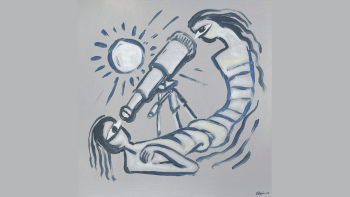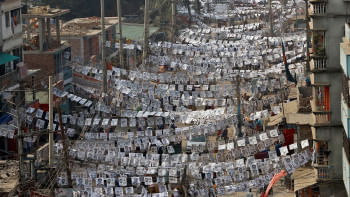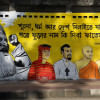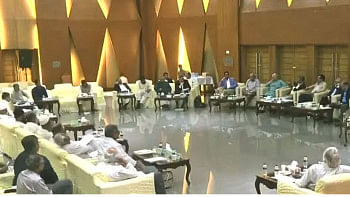My powerless poster walk

It was a random walk in the evening. The AQI score was up to 460 and something told me that it was okay to challenge my lungs, especially because some of us have signed up for the "Forever Bangladesh" project. The walls looked relieved, but half-washed, half-baked, half-cooked. The posters on these walls looked immature, premature, and reeked of an ugly redundancy all in the garb of an irrelevant sales pitch. They were all singing politicking praises of the heroes and aspirants, with pictures popping out of boxes, in careful dimensions, just about big enough not to offend the key leaders. In a few, I even spotted some where the heads of the actors had the central leaders' mugshots placed under them, almost in a postmodern style; almost defiant enough to make a point of lies being larger than lives.
Indeed, in spite of election season being over, and in spite of many posters being torn, I ended up counting 75 posters on a single wall in Banani last night. From shommelon, miladunnabi, to-let, sublet, ghotkali, physiotherapy, nursery admission, down to tutors, the posters all live together in perfect harmony in most neighbourhoods, barring the VVIP zones.
While silence is usually associated with the lack of communication, in reality, that may not always be the case, as words repeated too many times may become irrelevant and turn into propaganda. Propaganda, as we all know, often turns into pseudo communication, tainted by uncritical thinking. It relies on the addressee (in our case, innocent citizens) to be passive.
According to a recent study by the Environment and Social Development Organisation, in Dhaka city alone, the usage of posters rose by 51 percent in the last four years. There were 13,997 billboards in Dhaka in 2022, causing eye fatigue to 24.37 percent of people while 18.72 percent suffered from an overstimulated nervous system, 18.03 percent from insomnia, and 12.21 percent from headaches. Reportedly, 270,000 children suffer from eye fatigue annually.
Although we have the Graffiti Writing and Poster Sticking Control Act, 2012 to prevent visual pollution, nothing much has been done to implement it. Why, though?
It's not unreasonable to assume that posters and microphones are two key objects to use to sway the public. Pitching to the public has always been the point. But an overkill during the campaigns through visual and auditory mediums also carries a bad taste of an apple gone bad.
While I walked through my neighbourhood last night, and while I looked at hundreds of advertisements (in the form of posters, billboards, and neon signs), I really didn't "see" any and consciously registered none.
I must emphasise that there was literally zero communicative significance in any of them. The stimuli ended up bearing little or no significance as we never get to know any of our candidates through any of the campaigns. We get to know them from how our spaces look and feel, and by the range and level of corruption badges that they wear while strutting around us.
Let's not forget that there's also an element of repetition. While new posters (that is, ads) are launched for the same heroes and services over and over again, perhaps the expectation is for these to register in the public's mind. It was, after all, Hitler who said that the masses take a long time to understand, and therefore it is necessary to repeat "for a long time" till the public is conditioned to accept the claims of the pitches in the posters and adverts.
But how many people realise that speech may not always be about presence?
While silence is usually associated with the lack of communication, in reality, that may not always be the case, as words repeated too many times may become irrelevant and turn into propaganda. Propaganda, as we all know, often turns into pseudo communication, tainted by uncritical thinking. It relies on the addressee (in our case, innocent citizens) to be passive. While the pitcher uses adverts, the one pitched to soon realises that the language is not genuine, therefore leading them to disregard the message at least on the conscious level.
In Burundi, girls receive training to remain silent and be evasive. They are trained to listen to their families and then repeat verbatim to the males of the household.
Warhol's "Sleep," a six-hour-long film made in 1963. showed only one man sleeping. The screening allowed the audience to walk in, walk out, have a drink, chat over a burger and popcorn or even smoke a cigarette, only to go back to the screening room with an expectation of looking at a new shot of the sleeper's sleeping body.
Presidents and powerful people have also intelligently resorted to silence as a strategy.
President Reagan preferred helicopter press conferences, because neither could he hear the questions, nor could the reporters hear his answers, what with the helicopter's engines running, the blades rapidly spinning, and the tourists singing "God Bless America."
A classic example is Nixon's Cambodia Address delivered on April 30, 1970, wherein he presented three options: to "do nothing"; to "provide… military assistance to Cambodia," or "cleaning out." Instead of saying that he planned to invade Cambodia, Nixon took a longer route to condition US citizens and basically did what he wanted to do. Perhaps this way, power can also take a longer route.
In December 1981, Poland adopted martial law and imposed literal and metaphorical silence by stopping public communication. Television and radio channels were off air, newspapers and magazines weren't published, telephone lines were disconnected, and all mail was censored. Academic institutions and cinemas were closed. Public gatherings were banned, and many went to jail. None could travel.
Needless to say, the prism of silence benefitted none other than power.
The idea here should not be about a marketing gimmick of covering the walls with promotional pitches. The idea must be about creating a lasting impression of all the potential that comes with the face that wants to be elected to serve us, and not to be served. The walls should be able to breathe, the buses and gates can do with fresh coats of paints, the skies could be complimented by the uninterrupted gaze of those of us who live below. After all, it's our city, it's our space, and we have a right to at least clear vision, if not decent clean air anytime soon.
Dr Rubana Huq is vice-chancellor of Asian University for Women.
Views expressed in this article are the author's own.
Follow The Daily Star Opinion on Facebook for the latest opinions, commentaries and analyses by experts and professionals. To contribute your article or letter to The Daily Star Opinion, see our guidelines for submission.

 For all latest news, follow The Daily Star's Google News channel.
For all latest news, follow The Daily Star's Google News channel. 












Comments